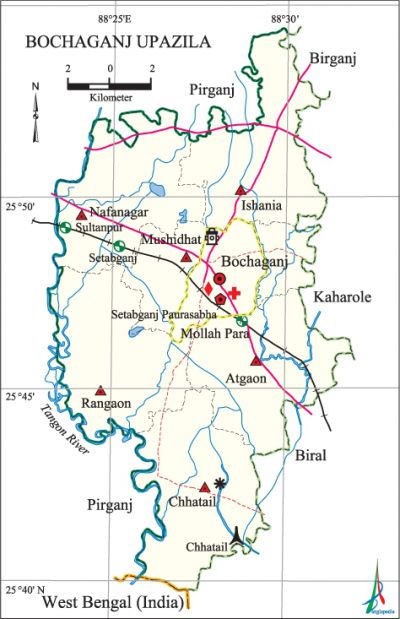Bochaganj Upazila
Bochaganj Upazila (dinajpur district) area 224.81 sq km, located in between 25°40' and 25°54' north latitudes and in between 88°23' and 88°32' east longitudes. It is bounded by birganj and pirganj (rangpur) upazilas on the north, biral upazila and west bengal of India on the south, Birganj, kaharole and Biral upazilas on the east, Pirganj (Rangpur) upazila on the west.
Population Total 145295; male 74589, female 70706; Muslim 87314, Hindu 55556, Buddhist 950, Christian 12 and others 1463.
Water bodies Main river: tangon.
Administration Bochaganj Thana was formed in 1915 and it was turned into an upazila in 1984. '
| Upazila | ||||||||
| Municipality | Union | Mouza | Village | Population | Density (per sq km) | Literacy rate (%) | ||
| Urban | Rural | Urban | Rural | |||||
|
1 |
6 |
144 |
141 |
24677 |
120618 |
646 |
60.4 |
48.9 |
| Municipality | ||||||||
|
Area |
Ward |
Mahalla |
Population |
Density |
Literacy rate | |||
|
10.22 |
9 |
33 |
24677 |
2415 |
60.4 | |||
| Union | ||||
| Name of union and GO code | Area (acre) | Population | Literacy rate (%) | |
| Male | Female | |||
|
Atgaon 13 |
9089 |
11447 |
10988 |
47.34 |
|
Ishania 40 |
8829 |
10999 |
10657 |
52.10 |
|
Chhatail 27 |
9656 |
10676 |
10027 |
48.47 |
|
Nafanagar 67 |
9149 |
10420 |
9870 |
52.18 |
|
Mushidhat 54 |
9233 |
8104 |
7595 |
45.24 |
|
Rangaon 81 |
9593 |
10192 |
9643 |
47.42 |
Source Bangladesh Population Census 2001,Bangladesh Bureau of Statistics.

History of the War of Liberation During the war of liberation in 1971 an encounter was held between the freedom fighters and the Pakistan army at Maherpur hat. The Pak army burnt and sacked a number of nearby villages. Besides, 6 Pak soldiers were killed in a mine explosion by the freedom fighters at Pulerhat of the upazila.
Marks of War of Liberation Mass grave 1 (Chhatail); Mass killing site 1 (Bhabaldighi).
Religious institutions Mosque 211, temple 91, church 1.
Literacy rate and educational institutions Average literacy 50.9%; male 58.7%, female 42.8%. Educational institutions: college 6, vocational institute 1, secondary school 49, primary school 120, madrasa 15. Noted educational institutions: Setabganj Degree College (1967), Mollah Para Bilateral High School (1913), Setabganj Pilot High School (1938), Nehalgaon High School (1946), Batasan High School (1966), Setabganj Girls' School (1973), Setabganj Kamil Madrasa (1957).
Newspapers and periodicals Weekly: Tulai; fortnightly: Joddha.
Cultural organisations Library 2, club 40, cinema hall 2.
Important establishments Sada Mahal, Shalban.
Main sources of income Agriculture 60.74%, non-agricultural labourer 3.13%, industry 0.64%, commerce 9.64%, transport and communication 2.26%, service 7.17%, construction 13.46%, religious service 0.1%, rent and remittance 0.15% and others 2.71%.
Ownership of agricultural land Landowner 50.2%, landless 49.8%; agricultural landowner: urban 32.76% and rural 53.74%.
Main crops Paddy, jute, oil seed, sugarcane, potato, pulse.
Extinct or nearly extinct crops Aus paddy.
Main fruits Mango, banana, jackfruit, blackberry.
Fisheries, dairies and poultries Fishery 5, dairy 25, poultry 78.
Communication facilities Pucca road 74 km, semi-pucca road 50 km, mud road 345 km; railway 18 km.
Extinct or nearly extinct traditional transport Palanquin, bullock cart and horse carriage.
Noted manufactories Rice mill, saw mill, husking mill, sugar mill, biscuit factory.
Cottage industries Goldsmith, blacksmith, potteries, weaving.
Hats, bazars and fairs Hats and bazars are 28, fairs 1; Bochaganj Hat and Setabganj Mela are notable.
Main exports Paddy, rice, jute, potato, sugar.
Access to electricity All the wards and unions of the upazila are under rural electrification net-work. However 12.47% of the dwelling households have access to electricity.
Sources of drinking water Tube-well 96.01%, pond 0.03%, tap 0.56% and others 3.4%.
Sanitation 14.23% (rural 9.48% and urban 37.67%) of dwelling households of the upazila use sanitary latrines and 18.66% (rural 16.02% and urban 31.66%) of dwelling households use non-sanitary latrines; 67.11% of households do not have latrine facilities.
Health centres Hospital 1, Union health and family planning centre 6, satellite clinic 1.
NGO activities Operationally important NGOs are brac, CARE. [Rezaul Karim]
References Bangladesh Population Census 2001, Bangladesh Bureau of Statistics; Cultural survey report of Bochaganj Upazila 2007.
